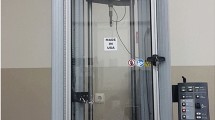Abstract
E-glass/epoxy composite is very prone to small impact such as dropping tools or splash rocks, which can cause damage or degradation to E-glass/epoxy composite components. A progressive damage model for E-glass/epoxy composite in ABAQUS Explicit was developed in this study to numerically predict low-velocity impact (LVI) damage and residual strength of an E-glass/epoxy composite component. Hashin-Rotem criteria were used to define laminate damage initiation, and traction-separation law was used to define the cohesive region. LVI and four-point bending after the impact (BAI) of the woven E-glass/epoxy composite plates were simulated and compared with available experimental data in the literature. Good agreement was found between finite element analysis (FEA) predictions and the experimental results, which include the impact zone shape, as well as the load-deflection response and residual bending strength from the four-point bending tests.
Similar content being viewed by others
References
M. V. Donadon and S. F. M. De Almeida, Chapter 2.07 — Damage modeling in composite structures, Comprehensive Materials Processing, 2 (2014) 111–147.
A. Matzenmiller, J. Lubliner and R. L. Taylor, A constitutive model for anisotropic damage in fiber-composites, Mech. Mater., 20(2) (1995) 125–152.
K. V. Williams and R. Vaziri, Application of a damage mechanics model for predicting the impact reponse of composite materials, Comput. Struct., 79(10) (2001) 997–1011.
S. S. Wang, Fracture mechanics for delamination problems in composite materials, J. Compos. Mater., 17 (1983) 210–223.
R. Dimitri, F. Tornabene and G. Zavarise, Analytical and numerical modeling of the mixed-mode delamination process for composite moment-loaded double cantilever beams, Compos. Struct., 187 (2018) 535–553.
L. Zhao, J. Zhi, J. Zhang, Z. Liu and N. Hu, XFEM simulation of delamination in composite laminates, Compos. Part A: Appl. Sci. Manu., 80 (2016) 61–71.
S. Wicaksono and G. B. Chai, A review of advances in fatigue and life prediction of fiber-reinforced composites, Proc. Inst. Mech. Eng. Pt. L: J. Mater. Des. Appl., 227(3) (2012) 179–195.
V. D. Azzi and S. W. Tsai, Anisotropic strength of composites — Investigation aimed at developing a theory applicable to laminated as well as unidirectional composites, employing simple material properties derived from unidirectional specimens alone, Exp. Mech., 5(9) (1965) 283–288.
S. W. Tsai and E. M. Wu, General theory of strength for anisotropic materials, J. Compos. Mater., 5(1) (1971) 58–80.
O. Hoffman, The brittle strength of orthotropic materials, J. Compos. Mater., 1(2) (1967) 200–206.
Z. Hashin, Fatigue failure criteria for unidirectional fiber composites, J. Appl. Mech., 48(4) (1981) 846–852.
H. R. Wang, S. C. Long, X. Q. Zhang and X. H. Yao, Study on the delamination behavior of thick composite laminates under low-energy impact, Compos. Struct., 184 (2018) 461–473.
S. Long, X. Yao and X. Zhang, Delamination prediction in composite laminates under low-velocity impact, Compos. Struct., 132 (2015) 290–298.
A. C. Manalo, T. Aravinthan, W. Karunasena and M. M. Islam, Flexural behaviour of structural fibre composite sandwich beams in flatwise and edgewise positions, Compos. Struct., 92(4) (2010) 984–995.
B. Li, M. S. H. Fatt and M. S. Hoo, Impact damage and residual strength predictions of 2D woven SiC/SiC composites, Finite Elem. Anal. Des., 113 (2016) 30–42.
N. K. Naik, Y. C. Sekher and S. Meduri, Damage in woven-fabric composites subjected to low-velocity impact, Compos. Sci. Technol., 60(5) (2000) 731–744.
ASTM D7136-12, Standard Test Method for Measuring the Damage Resistance of a Fiber-reinforced Polymer Matrix Composite to a Drop-weight Impact Event, ASTM International (2012).
A. Turon et al., An engineering solution for mesh size effects in the simulation of delamination using cohesive zone models, Eng. Fract. Mech., 74(10) (2007) 1665–1682.
ASTM D6272-17, Standard Test Method for Flexural Properties of Unreinforced and Reinforced Plastics and Electrical Insulating Materials by Four-point Bending, ASTM International (2017).
Acknowledgments
This research was funded by Kementrian Riset Teknolo-gi dan Pendidikan Tinggi Republik Indonesia (Developing Countries Partnerships Scholarship and Penelitian Dasar Unggulan Perguruan Tinggi), Institut Teknologi Bandung (P3MI), and Royal Academy of Engineering, UK (Newton Fund Industry-Academia Partnerships Programme).
Author information
Authors and Affiliations
Corresponding author
Additional information
Pham Xuan Quang is a Ph.D. candidate in Aerospace at the Pusan National University. He completed undergraduate study at Ho Chi Minh City University of Technology and his Master of Engineering at Institut Teknologi Bandung. He works on the finite element method, composite behavior, and reduced basis method.
Satrio Wicaksono is an Assistant Professor in the Faculty of Mechanical and Aerospace Engineering at the Institut Teknologi Bandung, where he has been a faculty member since 2012. He has been conducting several researches funded by various sources and contributing papers in international journals and conferences. He completed his Ph.D. and Master of Engineering at Nanyang Technological University and his undergraduate studies at Institut Teknologi Bandung.
Tatacipta Dirgantara is a Professor in the Faculty of Mechanical and Aerospace Engineering at the Institut Teknologi Bandung, where he has been a faculty member since 2006. He has been undertaking several researches funded by various sources. He has been contributing papers in international and national journals and conferences. He completed his Ph.D. at Queen Mary, University of London and his master and undergraduate studies at Institut Teknologi Bandung. He has involved in several industrial services ranging from aircraft structure, port equipment, oil and gas as well as mining facilities.
Rights and permissions
About this article
Cite this article
Quang, P.X., Wicaksono, S., Dirgantara, T. et al. The effect of low-velocity impact on the flexural strength of E-glass/epoxy composite plates. J Mech Sci Technol 34, 1879–1886 (2020). https://doi.org/10.1007/s12206-020-0409-8
Received:
Revised:
Accepted:
Published:
Issue Date:
DOI: https://doi.org/10.1007/s12206-020-0409-8




